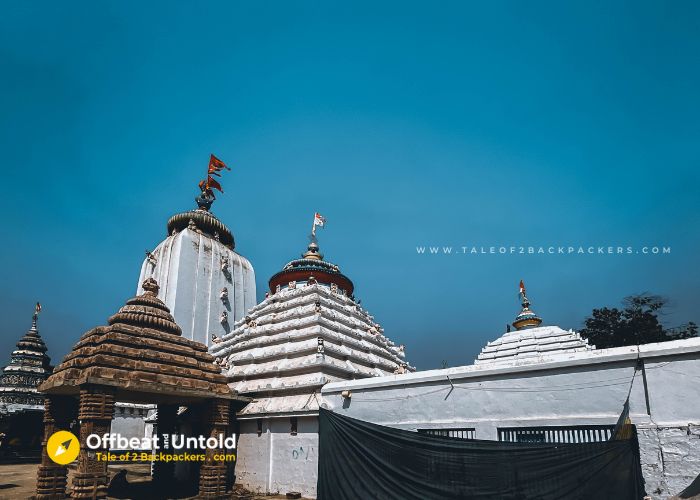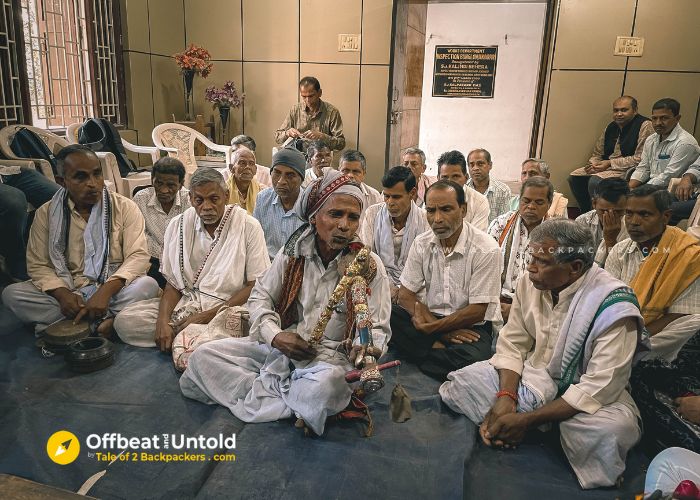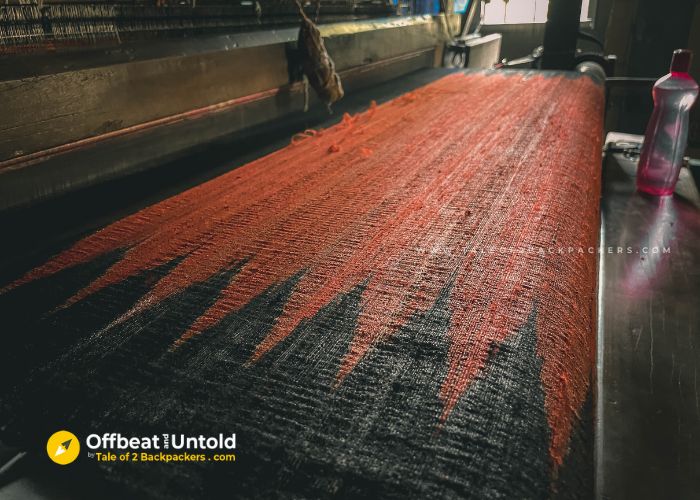About this Blog: Jajpur is quite an old town steeped with history and legends of the past. Recently we were fortunate to attend Jajpur Mahotsav 2023 and explore Jajpur as well. Read this blog to know about the history of Jajpur, its past and present along with the places to visit in Jajpur. Hope you enjoy reading about this lesser known place in Odisha.
Jajpur in Odisha is a small town steeped in history and heritage. India is an ancient land that has history, myths and legends dating back to centuries. While the towns of Kashi, Ayodhya and Haridwar are well known pilgrimage places, there are many smaller towns that are equally important in terms of the ancient history of the country. Jajpur in Odisha is an example of such a place. Famous for Biraja Devi Temple, which is also a Shaktipeeth, Jajpur is also known for ancient temples and several other archaeological sites.

From the 8th century to the mid 10th century CE, Jajpur was the capital of Odisha region. Later the capital was shifted to other regions that included Bhubaneswar.
Like many others, we were also unaware of the importance of Jajpur in the ancient and medieval history of India. For us, it was just another town on our way towards Bhubaneswar and Puri. It was much later when we visited the Diamond Triangle in Odisha, we came to know about the place. Finally, we got the opportunity to attend the Jajpur Mahotsav 2023 and explore the place. So here we are with another blog about Jajpur, its history and legends and all the interesting places to visit in Jajpur. Read on to know more.
Ancient History of Jajpur
While known for its rich mineral reserves and steel factories in the vicinity in recent times, the stories of Jajpur dates back to prehistoric times. Jajpur finds mention in Mahabharata and the Puranas and other ancient texts of India. Infact, the place has several names, all bearing testimony to the importance of the place. At times it has been called Biraja Khestra, while at other times, the place was known as Baitarini Ksetra.
Jajpur and the Puranic Times
The name Jajpur comes from the Sanskrit word “Yajpur” or Yagnapur. According to Brahmapuarana, it is believed that Lord Brahma had performed a Yagna here at the Brahma Kund. From the Yagna Vedi or the sacrificial altar appeared Devi Biraja. Lord Brahma himself installed the idol of Goddess Biraja at Jajpur.

The story of Sati and Shakti Peethas
Another interesting story is that of the Shakti Peetha. This is a story that we have all heard since our childhood. On the death of Goddess Sati, Lord Shiva became disconsolate. Such was his grief that hebcarried the body of Mata Sati on his shoulder reminiscing about their time together and roamed around the universe. His grief, sorrow and anger almost destroyed the universe. To save the universe, Lord Vishnu cut the body of Devi sati into 51 parts using his Sudarshana Chakra. All the 51 parts of the body fell at different parts of the Indian subcontinent.
The places where these parts fell became sacred sites and are known as Shakti Peethas. These religious sites are sacred to the Hindus and every year pilgrims travel to these places to pay homage. The navel part of Devi Sati fell at Jajpur. Here, the devi is known as Biraja Mata and is worshiped with much devotion.
Baitarani Tirtha

Jajpur is located on the banks of Baitarani River, which is believed to be one of the oldest and most sacred rivers of the land. According to Hindu mythology, one has to cross the mythical Vaitarani River to enter the higher realms.
Whether the Baitarani River of Jajpur is the same as the mythical Vaitarini, I do not know. However, the local people consider the river sacred and on its bank stands a few temples. Many fairs are also held at the banks of the Baitarani River.
The river is an integral part of the Tarpan rituals (rituals to pray for the deceased family members) that are performed here. Hence the place is also known as Baitarini Tirtha.
Jajpur and Mahabharata
Jajpur finds mention in the Mahabharata, the grand political saga. The Vana Parva of Mahabharata mentions that the Pandavas had visited the area during their exile.
Duryodhana’s wife Bhanumati was a Kalinga princess who is believed to have belonged to Jajpur.
Odisha has four sacred regions named after the four weapons of Lord Vishnu. Puri is known as Sankha (conch) Kshetra, Konark is known as Padma (lotus) Kshetra, Bhubaneswar is called Chakra Kshetra and Jajpur is known as the Gada Kshetra.
Jajpur and pre-historic times
Jajpur and its nearby areas have several archaeological sites belonging to different eras of prehistoric times. There are a few open-air paleolithic sites nearby Jajpur, all bearing testimony to ancient times. Various artifacts have been unearthed from these regions.

Jajpur and Medieval History
The Odisha region has been called by different names during the course of history. The region has been known as Kalinga, Utkala, Odra, Toshali and Odisha at various periods. However, Jajpur remained as the capital city for a long period of time. Several kingdoms changed hands, but Jajpur remained the capital.
Kalinga came under the rule of the Nandas of Magadh during the 4th century CE. It became an independent kingdom just before the rise of the Mauryan Empire.
It is well known that the Mauryan King Asoka ruled over Kalinga and it is under his rule Buddhism was spread in this region.
After the Mauryans, the Chedi Kings ruled over the area. The capital was shifted to Sisupalgarh from Jajpur.
In the mid-8th century CE, the Bhaumakars emerged as a powerful dynasty and ruled the region from Jajpur. It is interesting to note that in the 200 years and in between 18 monarchs of the Bhaumakar dynasty ruling the area, 6 of them were powerful women rulers. Culture flourished in this period in the form of literature, art, language and architecture.
Jajati Keshari and Jajpur
In the mid 10th century CE, Jajati – I of South Kosala won over the Bhaumakars. After a period of political turmoil, finally Chandihara of the Somvanshi dynasty rose to power. He called himself Jajati – II and was later known as Jajati Keshari.
Jajati Keshari had built many temples in the region including the Viraja Mata temple and the Varaha temple. He renamed the capital as Abhinava Jajatinagara. His son later built the Lingaraja temple in Bhubaneswar.
Dynasties changed but Jajpur remained the capital of the region for almost a century after which it was shifted to Cuttack.
In the 16th century, the region suffered destruction at the hands of Kalapahad who destroyed almost every temple in the region. He mutilated the idols and threw them away at the Baitarani River.
Jajpur of Today

Jajpur was carved out of Cuttack as an independent district in 1993. The region today is known for its mineral reserves and there are several steel factories in the vicinity.
Modern industries coexist with traditional small cottage industries. Jajpur is also known as the handicraft district of Odisha. The district is known for its traditional handicrafts like Tussar weaving, golden grass crafts and terracotta crafts.
It is also the home to a few dying performing arts like Kendara Gita. Altogether, Jajpur is a perfect combination of the past and present. It is a place with layers of history and heritage, a place of spirituality and blessed with natural beauty and resources.
Now that we have got a glimpse of the past and present of Jajpur, let us discuss the places to visit in Jajpur.
Places to visit in Jajpur
Jajpur town is located at the banks of Baitarani River and has several temples around the town. The main temple of the town is the Biraja Devi Temple, which is also one of the Shakti Peeths. Most of the places to visit in Jajpur revolve around the temples. Here is a list of places that you might consider visiting in Jajpur.
1. Biraja Devi Temple Complex

Biraja Devi Temple is the most important place of worship in Jajpur and is thus also the most crowded one. When we visited the Biraja Devi Temple in the morning it was bustling with people who had come there to offer their prayers.
There is a wall around the entire temple complex and from the outside the pristine white temple looks grand.

As we entered the temple complex, the first place we came across were two rooms filled with Shivalingas. Later, I came to know that this room is known as the Koti Linga. Jajpur is believed to be the land of Koti or 10 million Shivalingas. Many of the Shivalingas inside the room were Sahastralingas, i.e. miniature lingas are carved on single Lingas.

Next we came across a huge tree where people tie small red Chunris so that their wishes are fulfilled. Beside the tree is the Dola Mandap – a platform with an arch where the Devi comes out to play Holi. It is also known as Holi Mandap.
On the opposite side of the tree is another temple dedicated to Baba Vaidyanath.
Right in the middle of the temple complex is the main Biraja Devi Temple. However before entering the temple, we came across Nabhi Gaya.
Nabhi Gaya

Nabhi Gaya is an unique feature of the Biraja Devi Temple. It is the place to conduct post-life rituals for your ancestors. There is a structure where the pandits and people were throwing flowers after praying for their ancestors.
At one corner of the room is a small opening with small steps leading down to a Shivalinga. This is believed to be connected to the Ganga River.
After Nabhi Gaya, we entered the main Garbhagriha or the inner sanctum of the Biraja Devi Temple complex. It was full of people offering prayers to the deity. We too offered our prayers and thanked the goddess before coming out of the temple complex. In front of the temple, is a stone pillar on which a lion is carved. Lion is the Vahana of the Goddess.

There is another temple dedicated to Goddess Bagalamukhi at the back of the main temple.
After offering our prayers at the Biraja devi Temple, we came out and walked to the other end of the road to visit the Brahma Kund.
2. Brahma Kund

It is located just a few meters away from the Biraja Devi Temple Complex. It is the temple tank and the place where Lord Brahma performed the Yagna from where the Devi emerged. Brahma Kund was, once upon a time, surrounded by a forest called Champak van. Today, it is surrounded by a bustling town!
3. Varaha Temple

Our next stop was the Varahanatha Temple or the Varaha Temple. It is located on the left bank of the Baitarani River on the opposite side of the Dashaswamedh Ghat. The temple was built in the 15th to 16th century AD in the Kalinga architectural style. It contains a central Varaha shrine and several other smaller shrines of deities like Shiva, Vishnu, Vimala and others.
There is a small Hara Gouri Temple just outside the Varaha Temple Complex.
4. Jagannath Temple

After our visit to Varaha Temple, we crossed the river and visited the Jagannath Temple. Located on the banks of the Baitarani River near the Dashashwamedh Ghat, the white temple looks quite magnificent. The original temple was built by Anangabhima Deva III (1212 – 1238 AD) and was later destroyed by the Afghans chief Suliman Karani in 1568 AD. The present temple was renovated and rebuilt by Raghuji Bhonsle- I of Nagpur in the second quarter of the 18th century AD.
The architecture of the Temple is typical Odiya architecture and you will find deities of Lord Jagannath, Balarama and Subhadra inside the temple.
5. Saptamatrika Temple
Saptamatrika temple is located just at the Dashashwamedh Ghat. The temple is small, however, the idols inside are huge. The Saptamatrika Temple is dedicated to the seven mother Goddess who are the attendants of Goddess Biraja and are also protecting the inhabitants of Jajpur. The seven Goddesses are Shamshan Kali, Chamunda, Varahi, Indrani, Vaishnavi, Brahmi, Kaumari, Maheswari and Narsimhi. Each mother Goddess holds a baby in their arms.

Initially, there was a huge temple for the Saptamatrikas. But during the invasion of Kalapahad, the idols were thrown into the river. Later the idols were recovered and enshrined in the present place.
6. Siddha Ganesh Temple
This is located just beside the Saptamatrika Temple. There is a colossal image of Lord Ganesha. The temple also has an image of Jain Tirthankara Shantinatha and other small images.
7. Dashashwamedh Ghat

Located on the banks of the Baitarani River, Dashashwamedh Ghat of Jajpur is considered a holy place for the Hindus. There are several temples by the ghats that I have just mentioned. The Ghat looks serene and peaceful. I am sure it would be lovely to spend some time at the ghat early in the morning or in the evening.
8. Kusuma Lake
Kusuma Lake is a well-maintained and huge lake located in the middle of the town. Surrounded by trees, the lake is like a place of peace in the small bustling town. There is a walking path surrounding the lake.
Exploring Jajpur town took us half a day. In the evening we attended the Jajpur Mahotsav. There were various local performances as well as performances by noted Bollywood celebrities. There was also a local fair at Jajpur Mahotsav which we had much fun exploring.
Ratnagiri, Udayagiri and Lalitgiri – The Diamond Triangle of Odisha

If you have time, please visit the Buddhist trail of Odisha. Ratnagiri, Udayagiri and Lalitgiri are three excavation sites that clearly emphasizes the importance of Odisha in Buddhism. You can read about the Diamond Triangle in detail in our blog.
Handicrafts of Jajpur

The next day, we went on to visit Gopalpur village in Jajpur district. Please do not confuse the place with Gopalpur-on-sea, which is another very beautiful beach destination in Odisha. Gopalpur village in Jajpur is literally an art and craft village.

On arrival, we were greeted the traditional way and then we watched a local performance of Kendra Gita, a traditional Odia devotional song. Later we went on visiting the local handicrafts – tussar silk and golden grass craft.


It was quite an eventful day as we saw how tussar was weaved. We also observed how the golden grass craft had empowered the village women.
Jajpur Travel Guide
How to reach Jajpur?
The nearest airport to Jajpur Town is at Bhubaneswar. The distance from Bhubaneswar is about 100 km and takes about 2 hours to reach. You can get a car to reach Jajpur from Bhubaneswar.
Jajpur also has a railway station named Jajpur Keonjhar Road. Please note that Jajpur Keonjhar Road Railway Station is almost 30 km from the old Jajpur Town. Infact, this part is the new industrial area and is pretty modern. Most of the good hotels are also found in this area.

Where to stay in Jajpur?
As I mentioned, the new Jajpur Road area (the industrial area) has the most proper hotels. You can stay in this area. However, the old town is almost 30 km from this area.
What is the best time to visit Jajpur?
Winter months between November to February is the best time to explore Jajpur. The weather remains cool and it is comfortable to explore the temples and archaeological sites.
Where to eat at Jajpur?
If you want authentic Odia food, you can visit Odianee located at Panikoili. You will get simple food near the Biraja Temple area.
There are simple food joints and restaurants in the market areas as well.
In Conclusion
Jajpur town as well as the district had several places of interest that can be explored by the inquisitive travellers. The place, though a prominent pilgrimage, is not really on the tourist map. We had a grand time exploring Jajpur and an equally wonderful time at Jajpur Mahotsav. We hope to make our readers aware of such hidden treasures of India through our blogs.
If you liked this blog, please share it with your family, friends and neighbours. Would you like to visit Jajpur? Please let us know in the comments below.



Very nicely written post. It relived all the days spent in Jajpur.
I could have stayed there for another couple of days to cover things at leisure.
P.S. Your drone shots are good. 🙂
Thanks Nisha! I too miss the times.
Thanks for sharing this. Nicely explained. This will help in future travel plans.
Thank you!